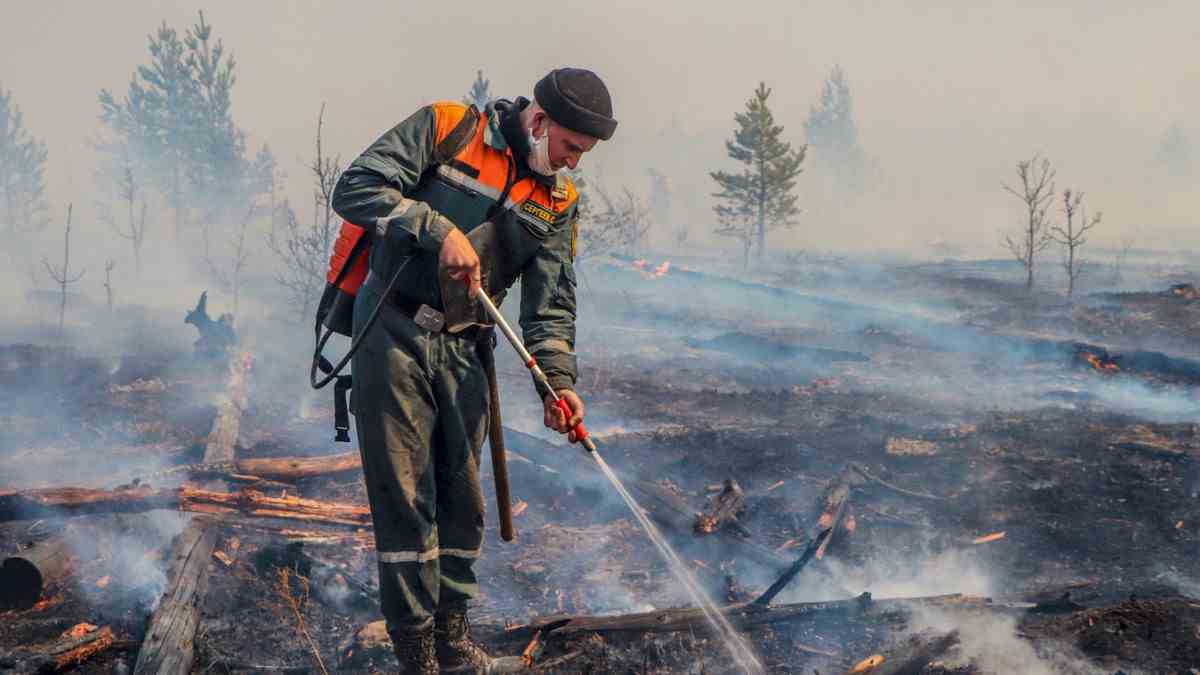A dense blanket of pitch-black smoke hangs over the country road, turning day into night. The forest around is in deep red flames. Only a group of white birch trees separates the cell phone camera from the inferno. “Terrible,” someone says off-screen. The video is said to have been made near the Siberian city of Omsk. A Twitter account called “Omsk Citizens’ Association” published it in mid-April.
“Not far from Omsk, along Cherlak Street, more than 100 hectares of pine forest are on fire,” the video reads. The smoke could be seen dozens of kilometers away. “Meanwhile, the governor of the region is holding a ‘Za presidenta’ festival,” writes the civic association, “and it’s not at all clear what the regional ministry for emergency situations is doing.” Bitterness can be read out of it: “Za presidenta” – for the president – is the motto for a martial arts festival in Omsk, the Z stands for the support of the Russian troops in Ukraine.
In fact, the Kremlin seemed long busy with other things while fires ate millions of hectares of Russia’s land and nearly 1,300 houses in more than 110 villages and settlements. 16 people died, these are the figures from the Ministry of Disaster Management from last week. It is true that in Siberia the forest burns every summer and the steppe every spring. Climate change, warmer, drier weather is a contributing factor. Most of the time, the fires then rage in remote, deserted regions where they can hardly be extinguished. This year, however, the fires are coming particularly close to villages and settlements.
On Twitter you can find many videos of the flames and the toxic smoke that hung in the cities of Novosibirsk and Krasnoyarsk. Sometimes the hashtag #своихнебросаем was written over these pictures – which means: “We will not let ours down”. With this slogan, the state advertises its “special military operation” in Ukraine, as the war in Russia should be called. The fact that it has now been used by victims of the fires for a different purpose also shows how alone these people feel.
An area larger than Luxembourg has already burned
Vladimir Putin only reacted to the situation the day after the annual Victory Parade, on May 10 he called an emergency meeting. Civil Protection Minister Alexander Chupriyan reported on the situation, speaking of 270,000 hectares of forest that had already burned this year, an area slightly larger than Luxembourg, and 4,000 individual fires. “We must not allow,” said Putin, “the situation of last year to repeat itself, when the forest fires were the longest and most intense in years.”
In 2021, the fire destroyed more than 18 million hectares of forest in Russia. At that time, the smoke traveled to the North Pole for the first time. Greenpeace in Russia has already reported that almost 5.2 million hectares of land are burning or burned this year. The organization relies on figures from the National Forest Service, which uses satellites to monitor these fires. The fact that they differ so greatly from those of the Minister of Disasters may be due to the fact that Chupriyan only counted pure forest fires.
However, most of the fires are currently raging in Russia’s steppes, on grasslands and agricultural land. They are burning not only in Yakutia, which was hit so hard last year, but in many regions, such as Omsk, Krasnoyarsk, Kurgan, Tyumen, Irkutsk. The fires spread particularly quickly because of the strong wind, the organization wrote last week and reported that a school, a kindergarten and a sawmill had also fallen victim to the flames.
According to Greenpeace, the sources of fire are often farmers and foresters who wanted to get rid of old grass, weeds or wood in this way, or garden owners who burn their waste. Greenpeace writes that when agricultural land becomes overgrown, owners and tenants face high penalties. “This forces them to clean surfaces in the simplest and cheapest way – with fire.”
There is a shortage of firefighters and equipment
The environmental organization also criticizes the Russian authorities for far more fundamental things: “There are still very few people, equipment and money to put out fires,” replies fire protection expert Grigory Kuksin when asked. “There are serious problems in the economy. We don’t have access to modern technologies.” At the same time, the climate was changing, and if fires increased, they would become more dangerous. For example, the risk of peat fires, which release a particularly large amount of greenhouse gases, and continue to smolder under the ice in the far north during the winter, is increasing.
The Avialessoochrana, the flying fire brigade of the Russian forest authority, reported 120 extinguished fires in 19 Russian regions on Monday – on that day alone. Paratroopers from the flying fire brigade were also involved in the extinguishing work. When forest fires raged in Yakutia last summer, the Russian military sent army helicopters and heavy cargo planes to help, dropping large volumes of water over the burning forest. Some international media are now quoting foreign experts who speculate that the military will have fewer resources to deploy inside Russia this year. In the country itself nobody wants to comment on that; for the wildfires of these weeks, fire-fighting planes are not that useful anyway. Whether there is a shortage will only become apparent later, when the forest fire season begins in summer.

